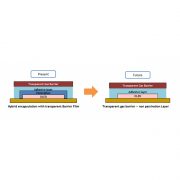OLED Encapsulation Transparent Gas Barrier Film Market, How High Can It Grow?
At present for flexible AMOLED encapsulation, thin film encapsulation, where organic and inorganic thin films are laminated, and hybrid encapsulation, where minimum passivation and gas barrier film are laminated, are used in mass production. As large area AMOLED panel is being mass produced through bottom emission structure where the light is emitted toward substrate, metal foil utilizing hybrid encapsulation is used.
However, TFE method which is used in flexible AMOLED panel for mobile device employs expensive manufacturing equipment and increases the investment cost. It also increases the number of processes involved and reduces mass production efficiency. For these reasons, this method is not suitable for cost reduction. As large area requires high resolution and high brightness, top emission structured AMOLED panel is being developed. When top emission structure is used, transparent encapsulation is essential.
Following this trend, the necessity for next encapsulation is rising, and in particular, transparent gas barrier film encapsulation is receiving increasing amount of attention. The transparent gas barrier film that is used for the hybrid structure currently being applied in mass production has WVTR of 10-4g/m2day, which is less than encapsulation requirement of 10-6g/m2day. However, in R&D stage, the WVTR level reached to 10-6g/m2day, and encapsulation could be possible only with transparent gas barrier film. Research development regarding this is being actively carried out.
According to 2016 OLED Encapsulation Report, published by UBI Research, transparent gas barrier film encapsulation can reduce investment cost compared to TFE. As it can also be applied to large area top emission structure, high market growth can be anticipated with this encapsulation.
UBI Research analyzed that if transparent gas barrier film encapsulation is applied to the new large area line and mobile added from 2017, the transparent gas barrier film market could grow to record up to approximately US$ 700 million in 2020.



